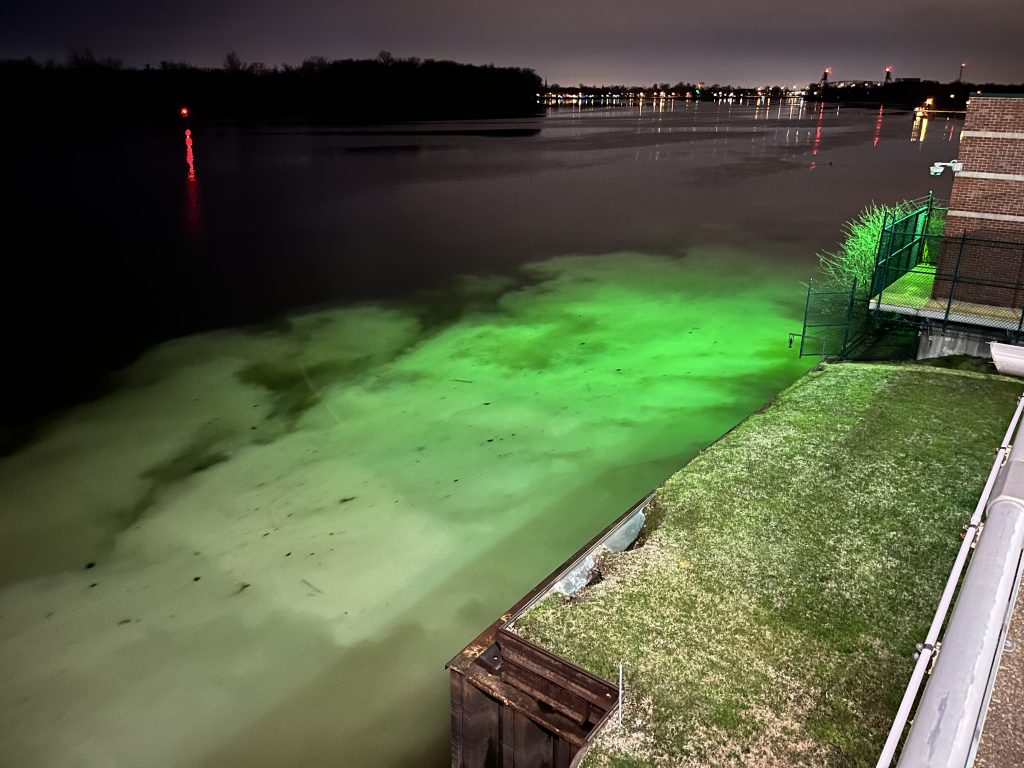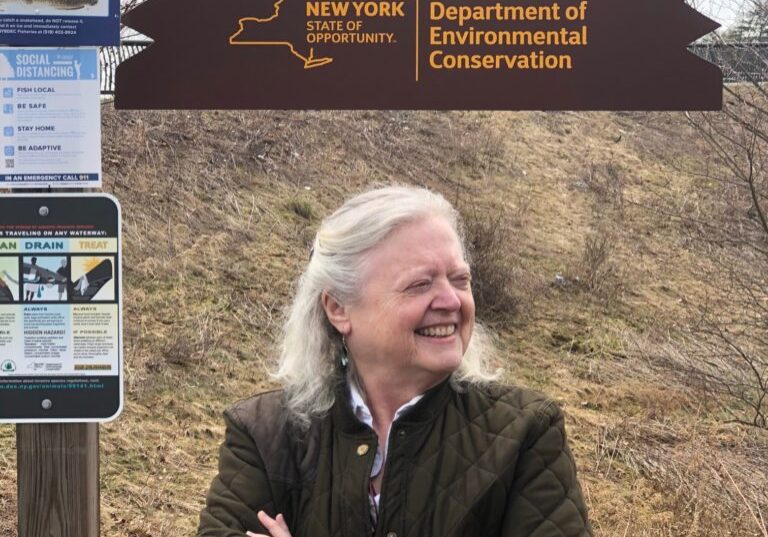
Response to 2023 Trinseo spill into the Delaware was slow and marked by botched communications, records show
| September 3, 2024
The response to a spill of 8,100 gallons of a latex product from a Bristol, Pa., facility into a creek that feeds the Delaware River in 2023 was punctuated by foot-dragging by the manufacturer, communications shortcomings among local, state and federal responders and garbled messaging to the public, government documents reveal.
The documents paint a picture of delays in the early response to the March 24, 2023, spill and show that the participating agencies — there were at least 15 — were overwhelmed by differing jurisdictions, competing interests and communication breakdowns.
In fact, a 200-page post-mortem of the response to the spill — known as an after-action report — conducted by Philadelphia’s Office of Emergency Management outlined nine “strengths” but four times as many “areas for improvement” that posed “significant challenges to operational success.”
Duane Hagelgans, an associate professor at the Center for Disaster Research and Education at Millersville University in Pennsylvania who teaches emergency management, reviewed the report.
“Communications always has to be the top priority,” he said. “We break down communications into internal and external communications. In this case they rightly dictate in this (after-action report) that they did neither well.”
Reporting for this article was drawn from more than 600 pages of internal records from the Pennsylvania Department of Environmental Protection, U.S. Environmental Protection Agency, the Delaware River Basin Commission and Philadelphia’s Office of Emergency Management that Delaware Currents secured through the Freedom of Information Act and other public records requests.
Philadelphia’s report, which is dated March 4, 2024, included specific recommendations to improve. However, 51 pages related to those recommendations were redacted by the city, which cited various exemptions to Pennsylvania’s Right to Know law as grounds for blacking them out.
The U.S. Coast Guard, which was the lead agency in responding to the spill, has so far not responded to a public records request that Delaware Currents filed in April. It said last week that the request was pending with the Coast Guard’s headquarters “due to its significance.”
The agency did not respond to a request for comment for this article.

What happened in those early hours
The spill of an acrylic polymer was first discovered at 10:30 p.m. on Friday, March 24, at Trinseo, which manufactures plastics and synthetic rubber, among other products. The spill was reported to the National Response Center a little less than an hour later.
Records show that the spill resulted from a damaged transfer pipe on the roof of a building, with the product then entering gutters, storm drains and stormwater basins leading to an outfall to Mill Creek, also known as Otter Creek, which connects three-quarters of a mile away to the Delaware River.
The Bucks County hazardous materials team was called to install a plug in the outfall pipe at the creek.
“Up to this point, efforts to stop the flow had been unsuccessful,” according to a Pennsylvania DEP report.
Trinseo’s early response to the spill, which gave the creek and river a milky sheen, was underwhelming, according to federal records, one of which noted: “The company did not perform prompt and effective mitigation efforts.”
Michael Blair, a Pennsylvania Fish and Boat Commission waterways conservation officer, stopped a manager who was leaving the Trinseo offices about eight hours after the spill was reported.
Blair asked for the name and contact information for “someone higher in authority” at the company, according to government records. When the manager replied that he didn’t know whether he was authorized to give out such information, “WCO Blair placed emphasis on how the response was inadequate due to the delays,” according to the records, which said the manager then returned to the building “to make additional calls.”
“It was explained the seriousness of this issue and how it needs to be elevated,” a Pennsylvania DEP report noted. “The company needs to have a plan with objectives and hire an environmental consultant.”
Trinseo, which is also known as Altuglas, did not respond to requests for comment.
An email from an emergency response coordinator for the Pennsylvania DEP noted that the Pennsylvania Fish and Boat Commission was on site and that its officers were “reading the (responsible party) the riot act for the slow response.”
The email added that a company representative “has been cooperative, but they weren’t able to get equipment in promptly, as had been requested.”
The Pennsylvania DEP report revealed that the area where the pipe broke was monitored by cameras but that the cameras did not record video and “just allow live feed viewing” in the control room. When Trinseo officials were asked whether anyone had been monitoring the cameras in the control room “no answer was provided,” according to the report.
Repeated water testing ultimately revealed no detectable elements of hazardous materials and a pollution team survey did not find any harmful impacts to wildlife.
During the emergency response, Philadelphia Water Department issued advisories suggesting residents buy bottled water out of an abundance of caution. The city draws nearly 60 percent of its drinking water from the Delaware.
Trinseo ultimately agreed to a $2.7 million settlement of a class-action lawsuit over economic harm suffered as a result of the spill that provided a base payment of $25 per claimant. Other possible enforcement action that might result in fines remains under review at the Pennsylvania DEP.

Botched communications
While Trinseo’s response to the spill was criticized in government records, an inward look by Philadelphia at its own response found three dozen shortcomings, ranging from a lack of clarity about backup water distribution systems to a lack of a formal plan for dealing with a disruption to water services.
Of the 36 areas where things fell short, more than half of them related to communications. Among them:
- It took a day to establish a communications coordination protocol.
- The city’s crisis communication plan was last updated in 2014.
- Crisis communicators were concerned that the frequency of messaging may cause public fatigue.
- The city’s various call centers used by residents when seeking information may become overloaded during a citywide event.
- Businesses were not prepared for a disaster of this scope.
- Disconnected business communication lists from multiple agencies made it hard to determine who was receiving what communications and prevented the prompt identification of the number and type of businesses likely to be impacted.
- Messages translated into other languages were frequently delayed in comparison to the English versions.
- Although there were scheduled calls, there was a real-time communications gap between the on-site incident command post at Trinseo and Philadelphia’s water quality officials.
“Disaster management, which is what this was, NOT a ‘water’ problem, required coordination and collaboration,” Hagelgans said in an email. “I could write a lot about their communications, or lack thereof, but it seems like decisions were being made that in hindsight were not the best.”
Stephanie Wein, clean water and conservation advocate for PennEnvironment, said the spill revealed the strengths and effectiveness of the Philadelphia Water Department’s advanced monitoring and warning systems but also a failure of its communications.
Alerts went to residents who were unaffected by the spill which, in turn, drove them to unnecessarily buy bottled water, which is not nearly as regulated as public water systems, Wein said. Further, bottled water is more expensive and generally contains more microplastics than public water supplies
“The communication was not clear in the type of threats, the timing of the threats and also they were too broad,” she said, adding that the ultimate effect was to erode consumer confidence in Philadelphia’s water safety.

Many cooks in the kitchen
At times, video calls among the various agencies and other interested parties had close to 90 participants, a circumstance that one on-scene coordinator for the EPA described in an email as “herding cats.”
Despite the best efforts of the authorities to inform the public as the emergency unfolded, the messaging was failing.
“By late Sunday morning, an evaluation of public awareness indicated that the previously disseminated messages, including blog posts, press conferences and social media content, were not registering with the public,” the after-action report noted.
Even the city’s health commissioner was “not initially engaged in communications about health risks to the city’s population,” the report noted.
That oversight was reflected in an email she sent to multiple recipients almost exactly 48 hours after the spill was first reported. The commissioner, Cheryl Bettigole, wrote that there were two chemicals potentially involved in the spill “but were not a focus of attention to this point.”
“It would be good to understand why we are not currently concerned about these two substances,” she wrote.

Where things went right
An EPA spokeswoman said the agency did not have a role in the unified command established to address the spill, a structured approach that accounts for the involvement of multiple agencies across jurisdictions in responding to an incident.
The EPA did respond to requests to provide “limited technical assistance, which included participating in certain conference calls and conducting water sampling and analysis of surface water from the Delaware River,” the spokeswoman said.
New Jersey Department of Environmental Protection, which was part of the unified command, “was engaged throughout the incident to ensure the flow of timely information to critical partners, including New Jersey water systems that rely on the Delaware River as well as local offices of emergency management,” a department spokesman said. “While New Jersey did not experience impacts to drinking water or natural resources from this incident, it did reinforce the importance of local, state and federal partnerships across the shared Delaware River watershed.”
A Pennsylvania Department of Environmental Protection spokesman described the agency’s messaging as “accurate, consistent and timely,” and noted, “The coordination efforts among our programs, sister agencies and external partners during this incident was handled in a professional and timely matter.”
Bucks County Emergency Management Agency, which was also part of the unified command, and the Philadelphia Water Department and the city’s press office did not respond to requests for comment for this article.
Philadelphia’s report did cite cases where things went right: The Delaware Valley Early Warning System, a notification system for spills, provided crucial information and the city’s crisis communications group held a virtual meeting within an hour of forming.
The after-action report noted that “dedicated and experienced city staff directly contributed to the successful response by recognizing the potential dangers” and quickly organized a response to mitigate threats to the city’s water supply.
(Separately, a DRBC panel formed in June, the Subcommittee on Sourcewater Protection, will focus on inter-agency communications and to provide a forum for agencies responding to threats to the drinking water supply.)
Cleanup contractors monitored the outfall from the Trinseo facility and used vacuum trucks to collect any residual product that was still seeping through. The contractors ultimately collected 200,000 gallons of contaminated water, according to an EPA report, and by April 20, the command structure overseeing the emergency response was deactivated.



![DC_Image [Image 4_Assunpink Meets Delaware] meets Delaware The Assunpink Creek on its its way to meet the Delaware River. The creek passes through woods, industrial and commercial areas and spots both sparkling and filled with litter.](https://delawarecurrents.org/wp-content/uploads/bb-plugin/cache/DC_Image-4_Assunpink-meets-Delaware-1024x768-landscape-14f069364113da5e8c145e04c9f2367c-.jpg)




Great story, Chris. Covered a lot of bases. Good use of documents.
I wonder how — if at all — these agencies are applying what they learned to being ready for the next emergency spill. I also wonder how and where the cleanup contractors disposed of what they retrieved.